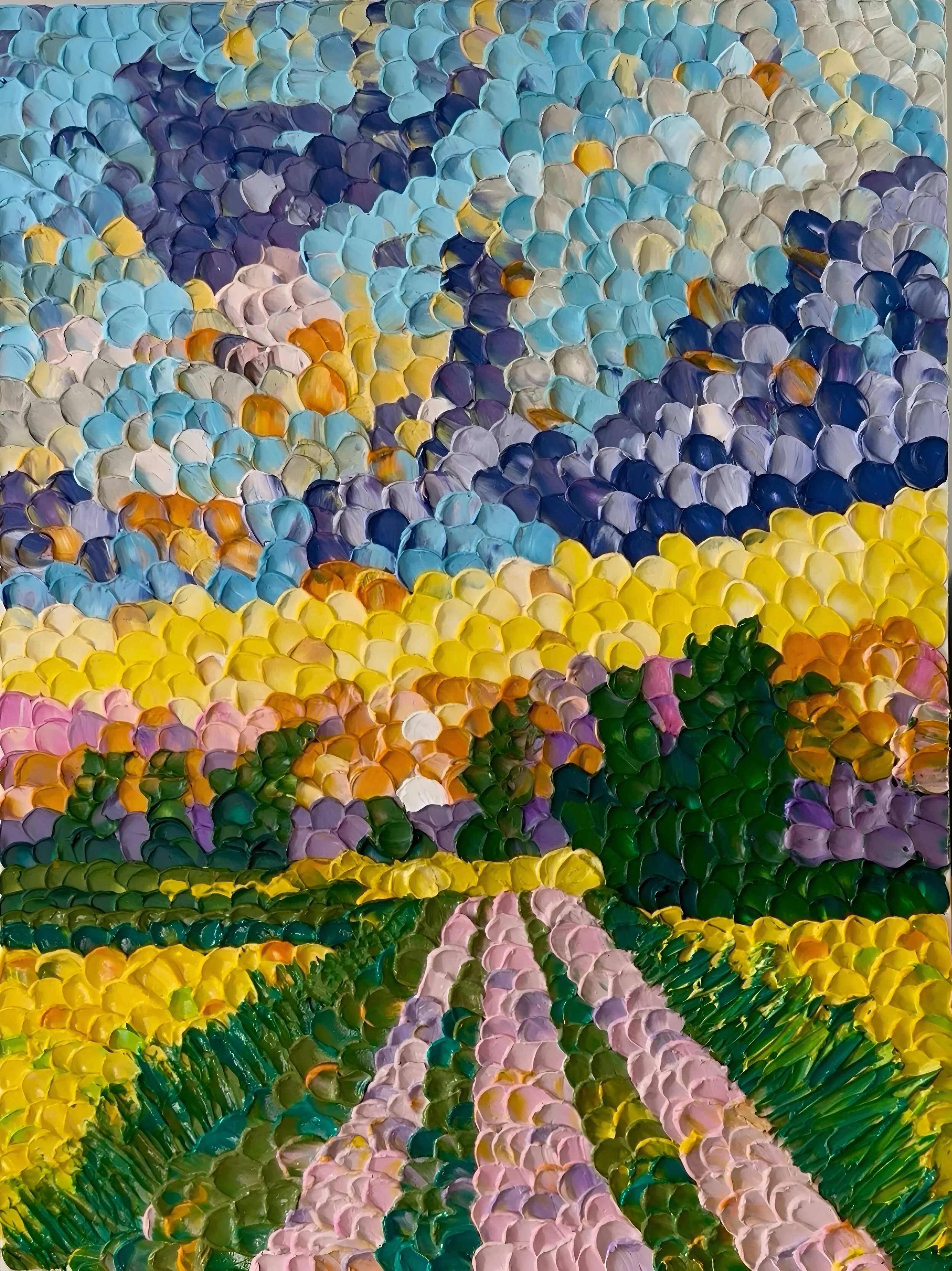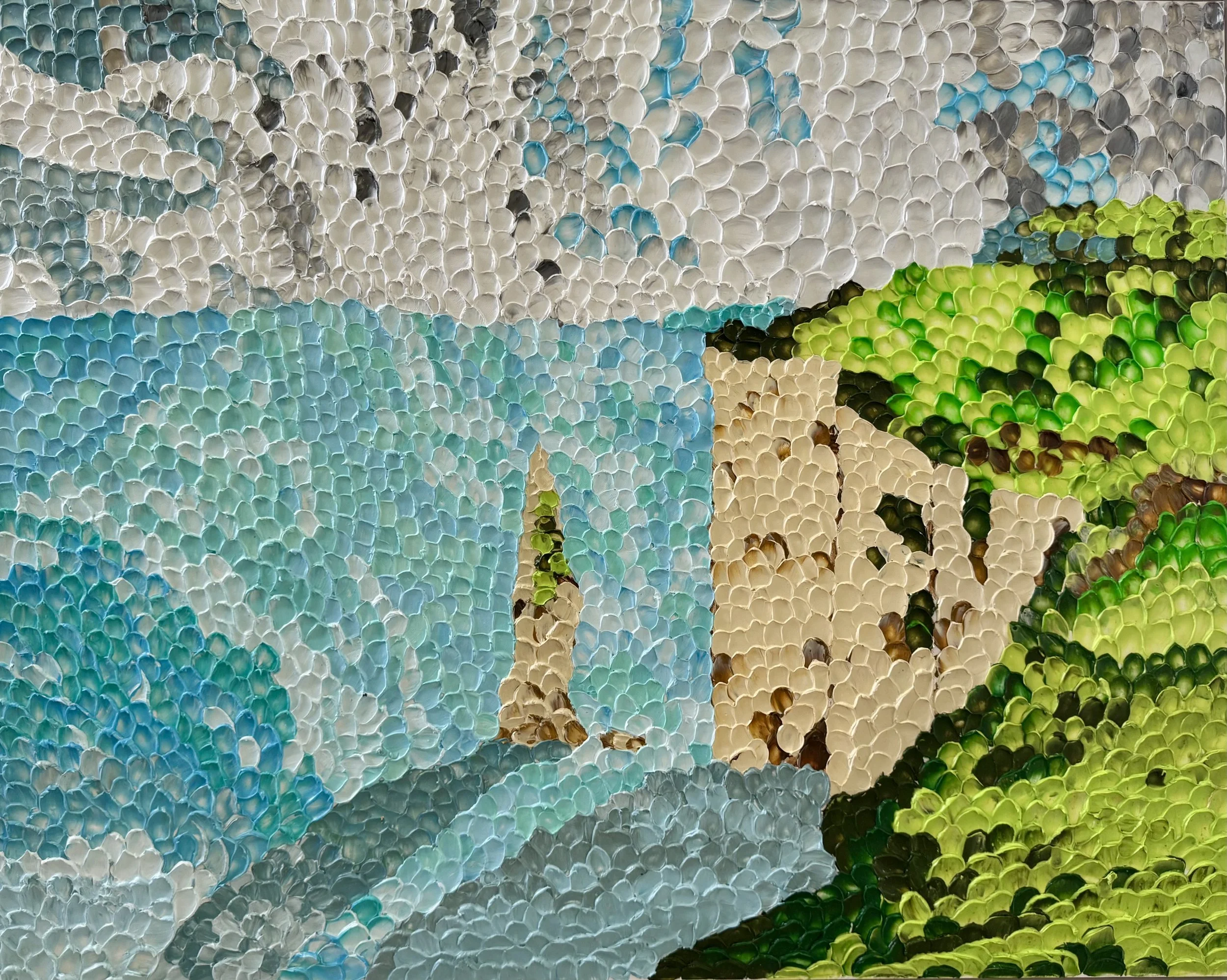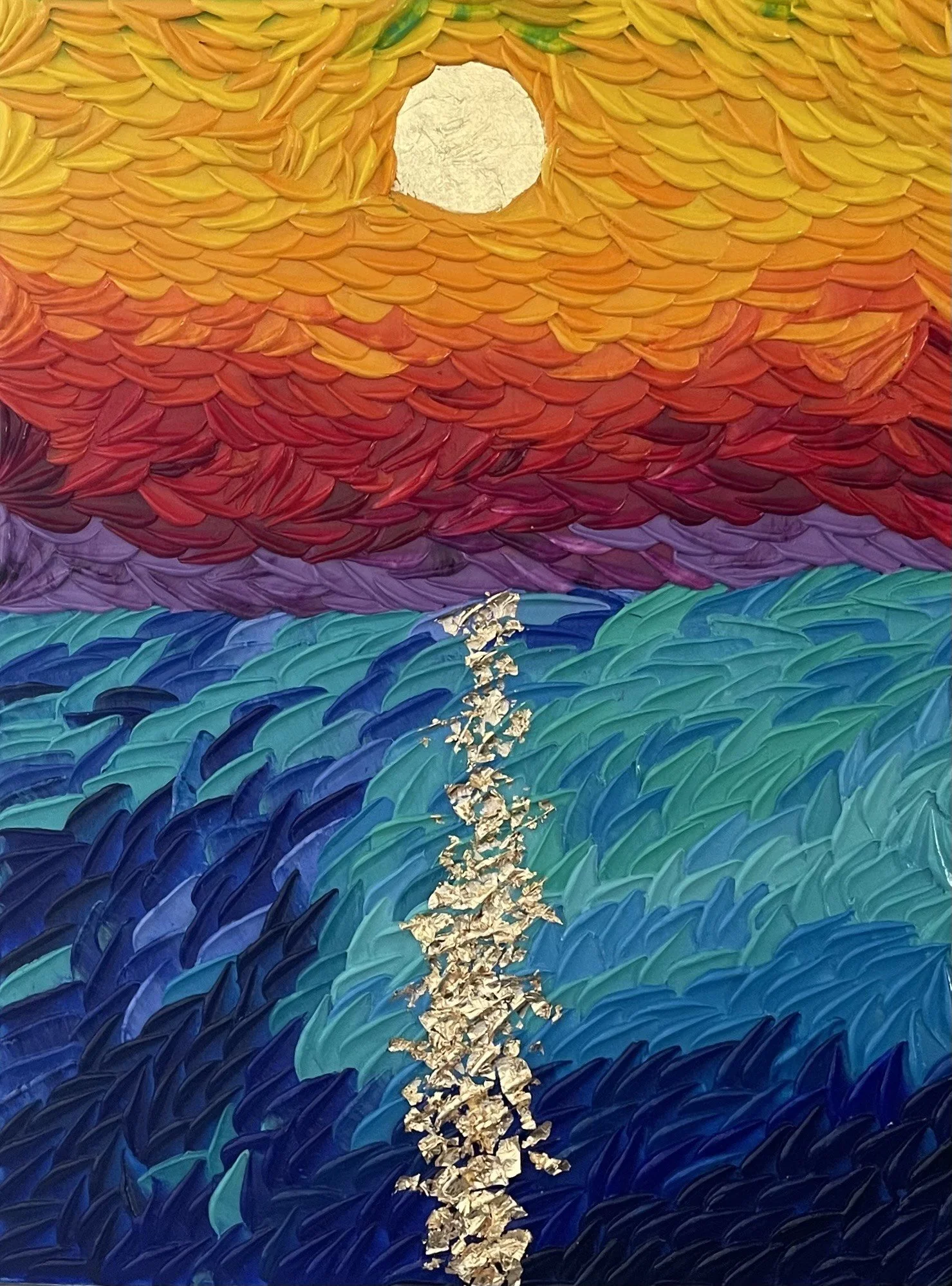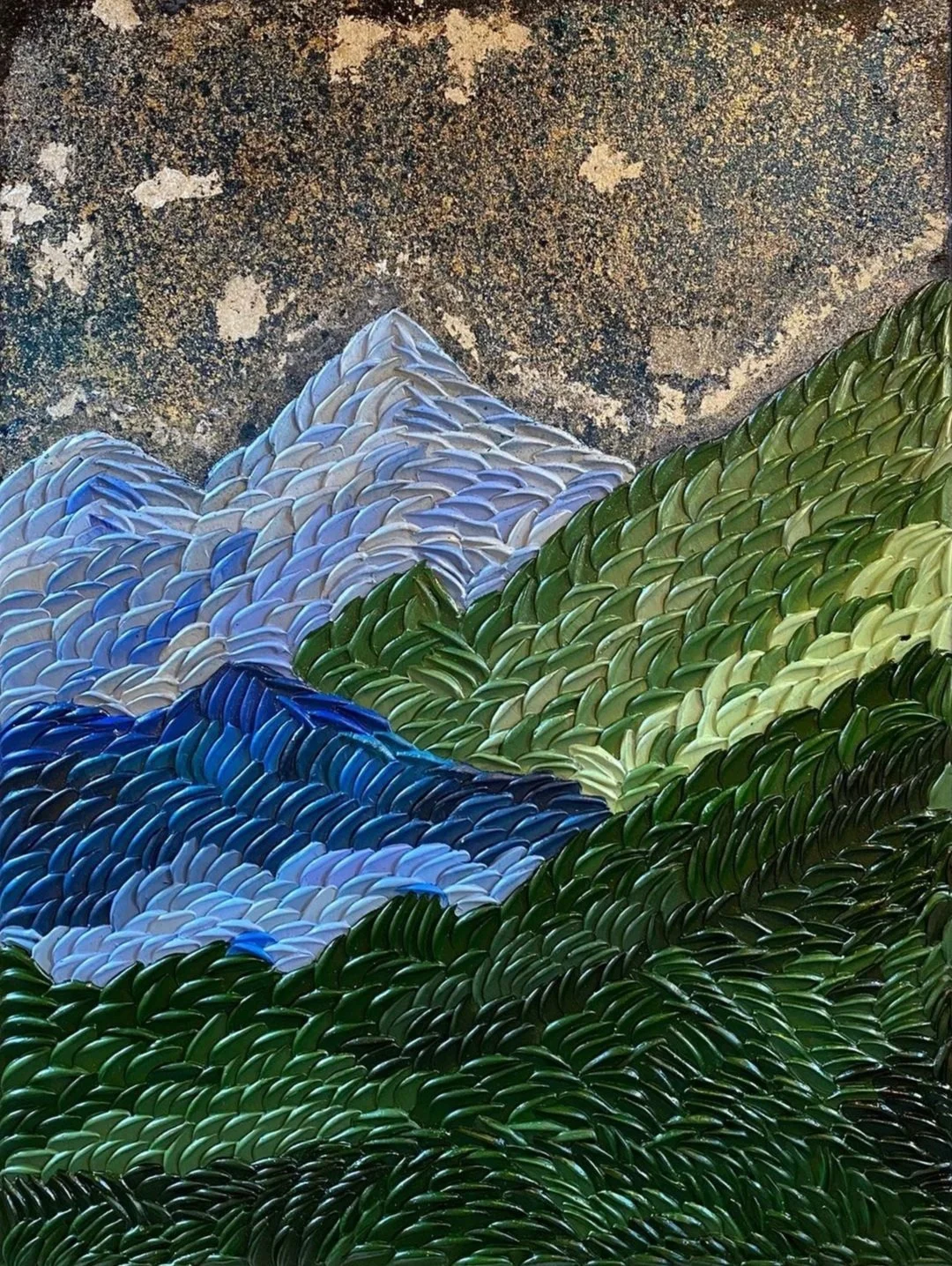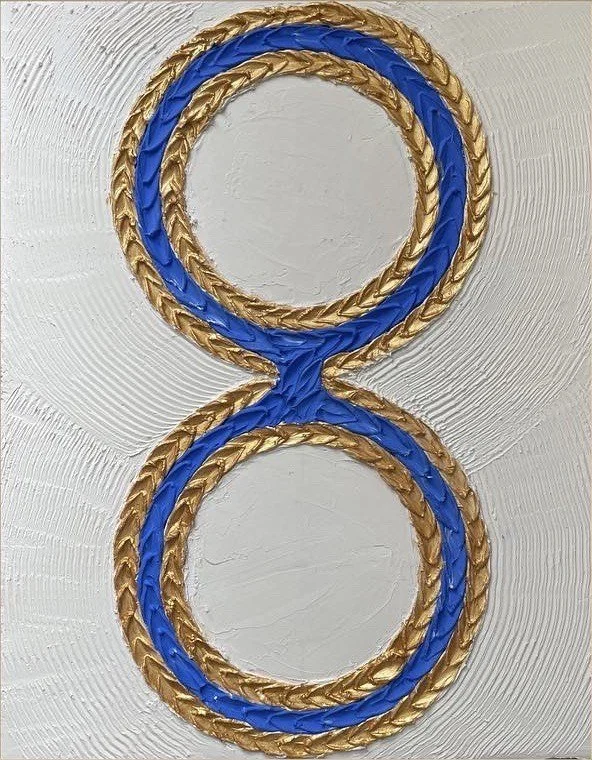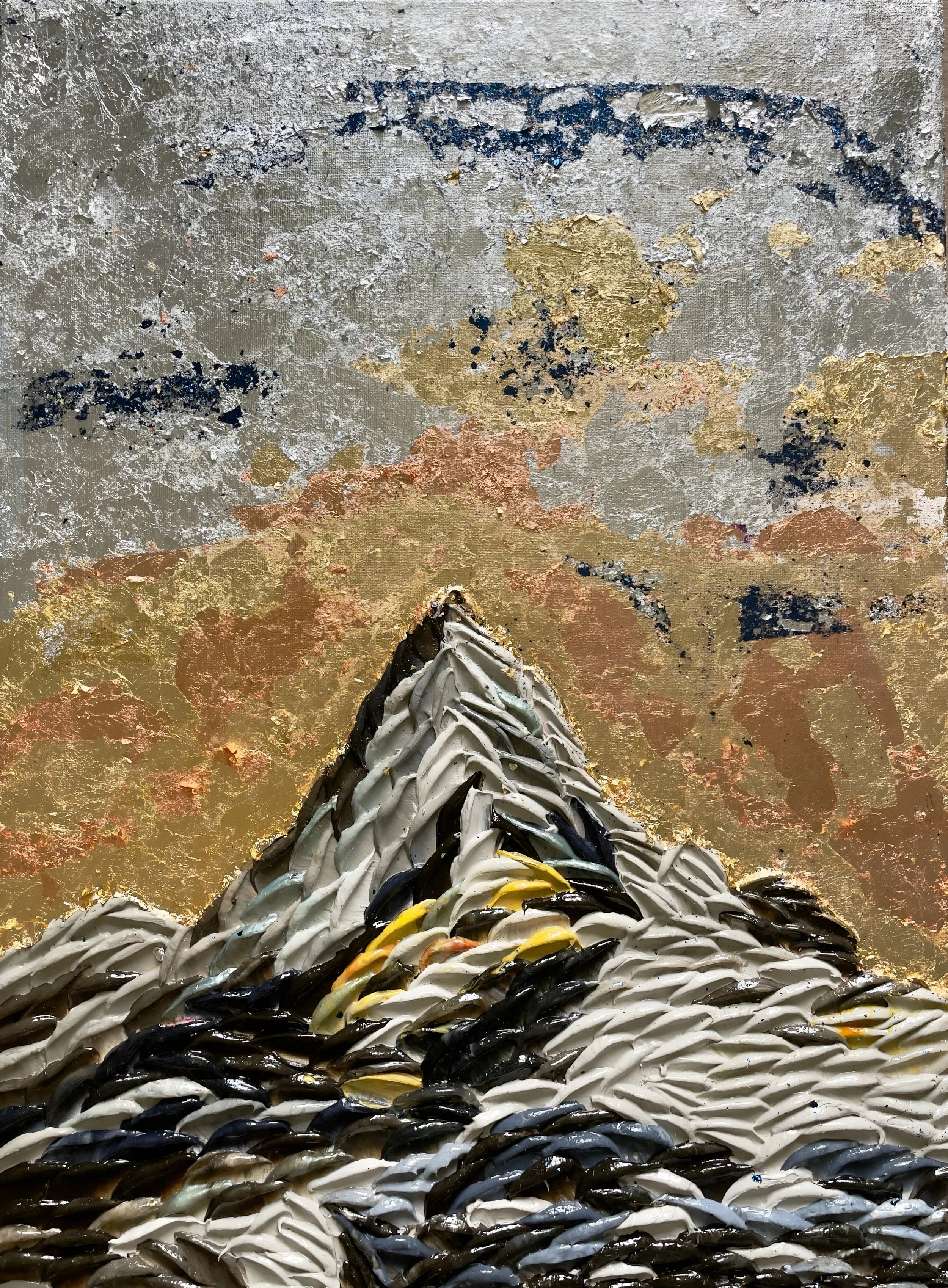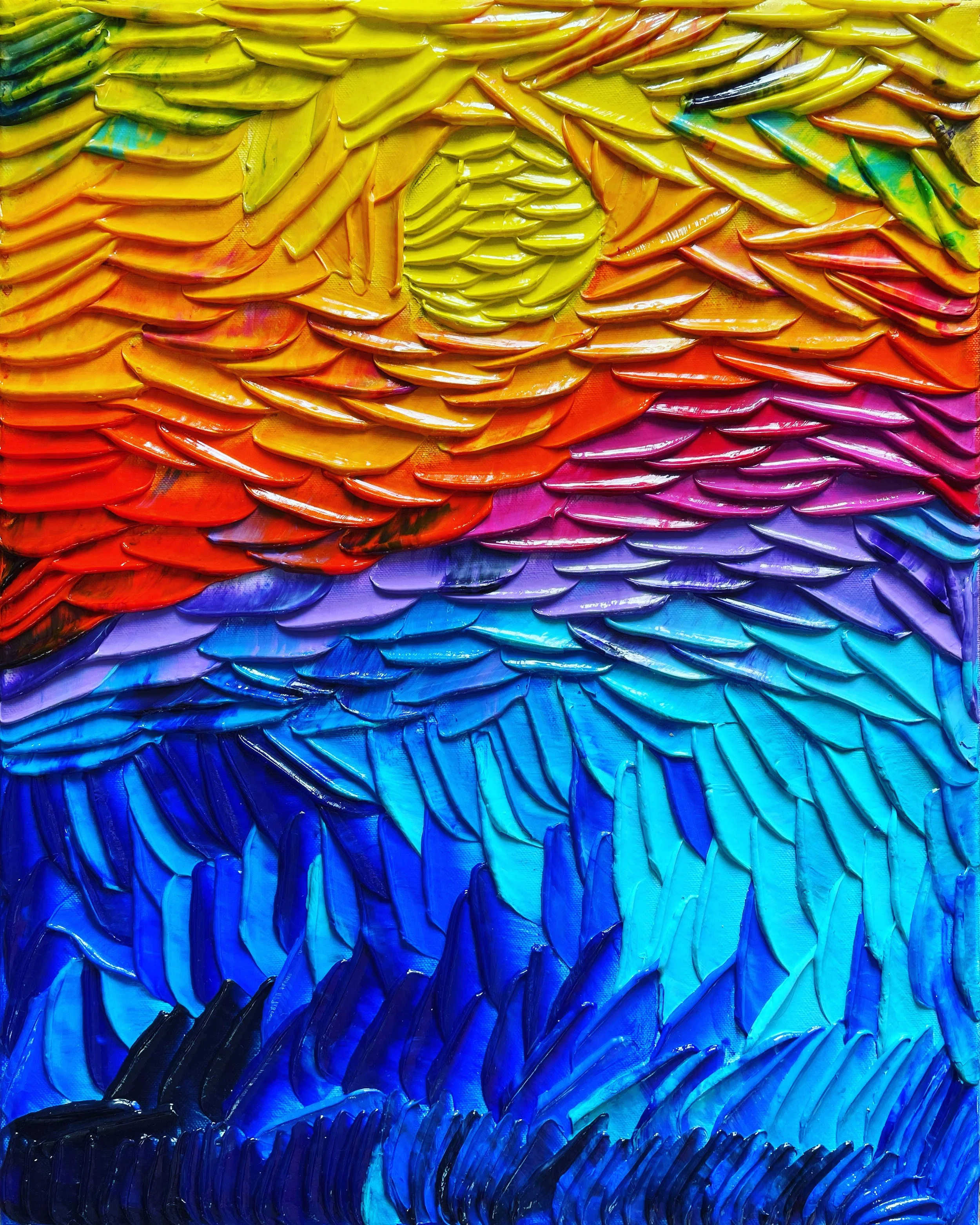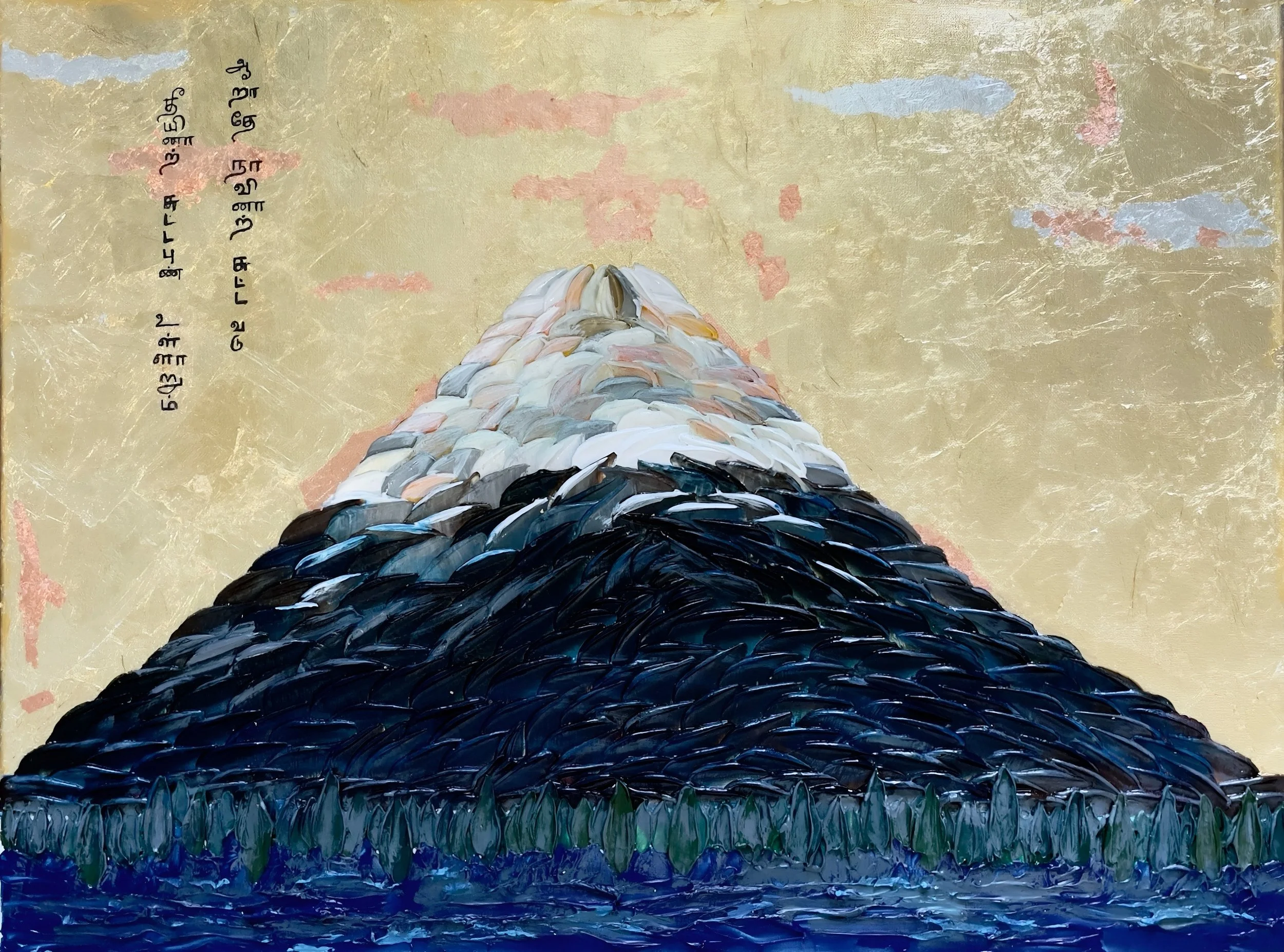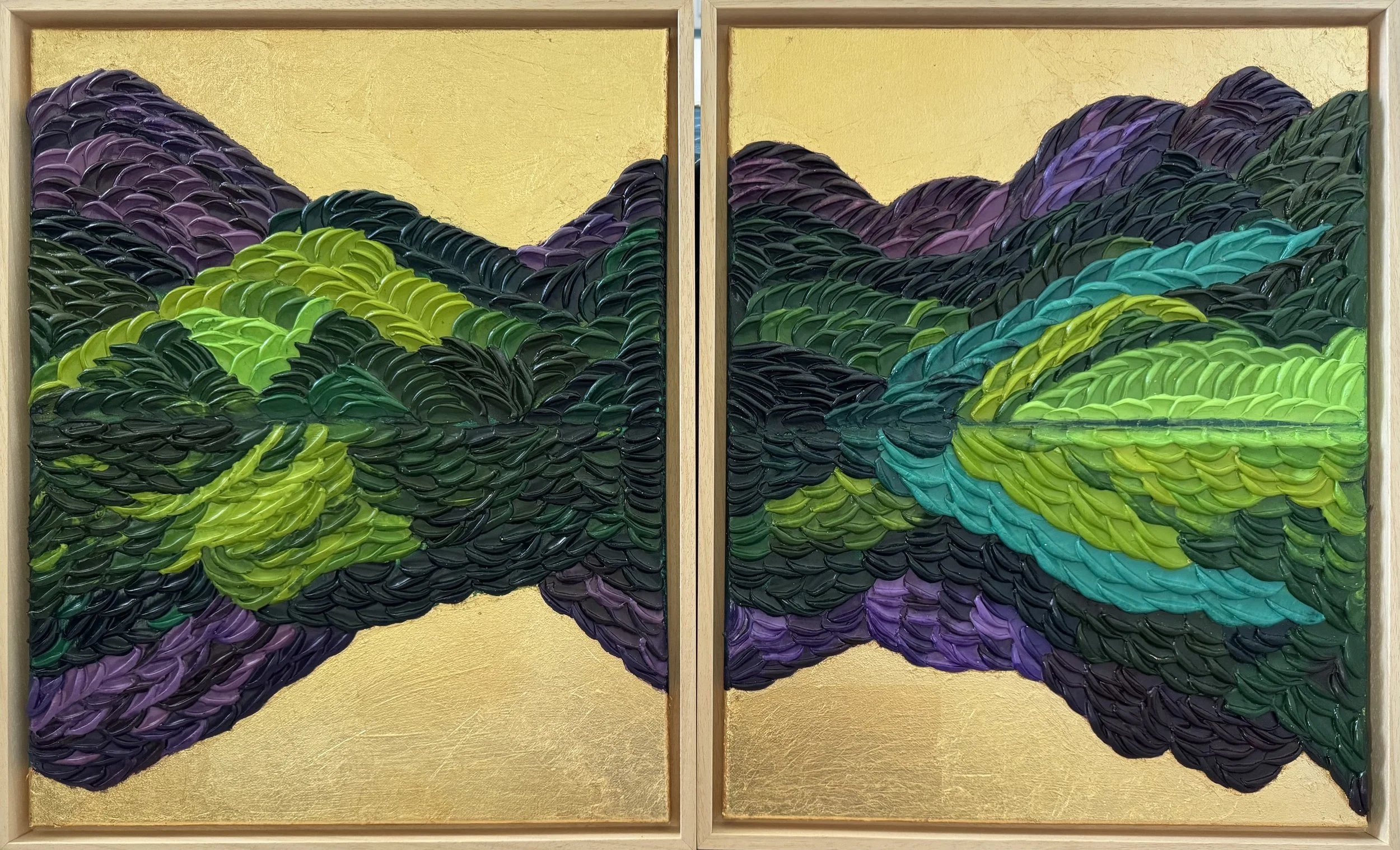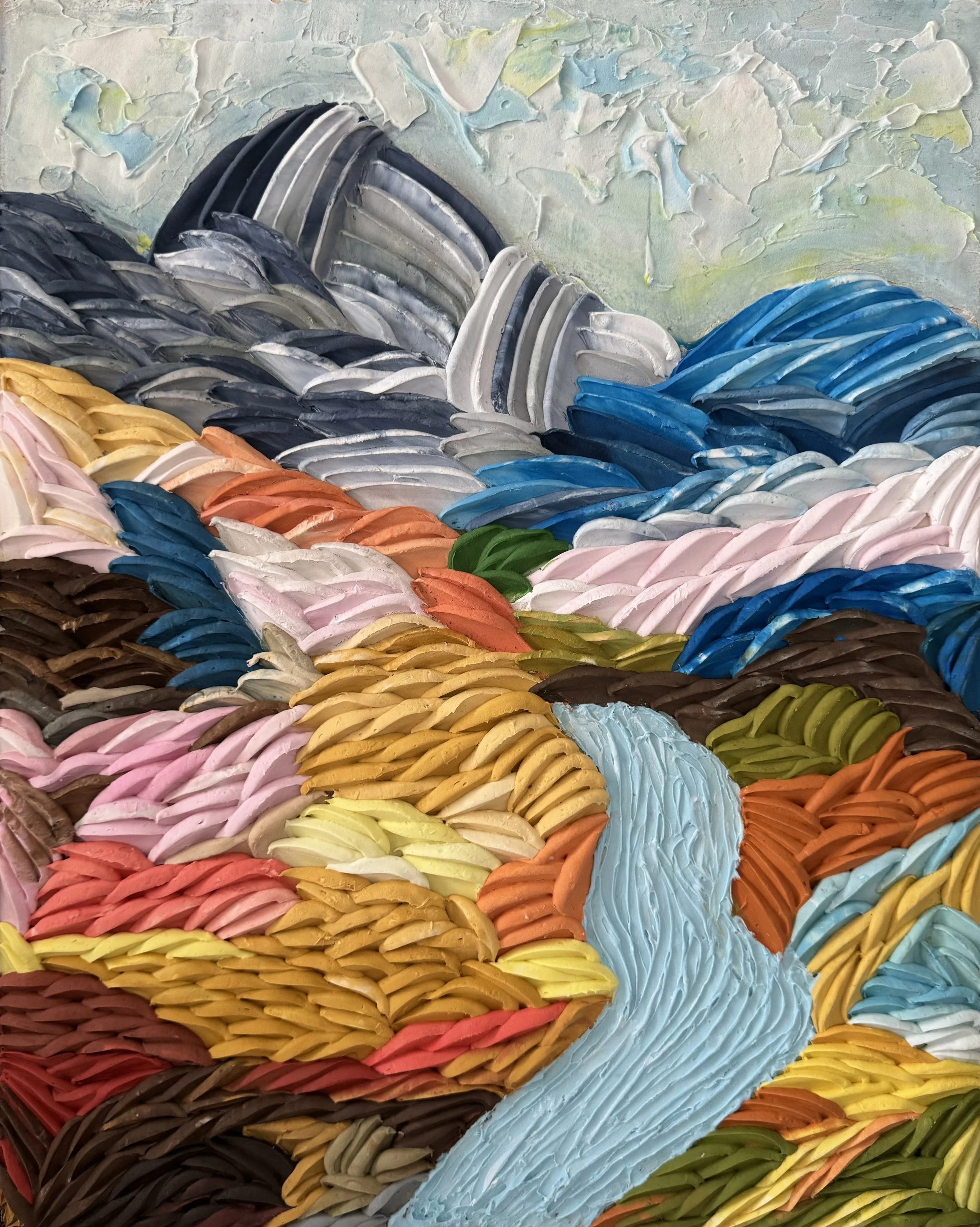Gayathrisai Chandrasekaran
Gaya Chandrasekaran is a London-based contemporary artist. Born in the coastal city of Chennai, India, she draws deep inspiration from the vivid colours and rich cultural heritage of her upbringing. Working in textured acrylics layered with palette knives and gilded with gold leaf, her paintings evoke depth, movement, and emotion — inviting viewers into contemplative spaces of memory, nature, and transcendence. She has trained in India and at the Slade School of Fine Art in London.
Her practice has been recognised internationally with the Collectors Art Prize | Art Legends of Our Time and a shortlist for the VAA Art500 International Art Prize.
Chandrasekaran’s works have been exhibited widely across the UK, US, and Europe, and featured in prominent art publications. Reviewed by Tabish Khan, a leading London art critic, her paintings are held in private collections across the US, UK, Spain, Italy, Brazil, and India — including a permanent display at the London Business School.
Gaya, your practice is rooted in textured acrylics, palette knife layering, and the shimmering resonance of gold leaf. In many ways, this material language appears not just as a technique but as a philosophy, the weight of texture mirroring the density of lived experience, and the radiance of gold echoing both spiritual abundance and fragility. Could you expand on how these formal decisions carry meaning beyond the surface, becoming metaphors for memory, transcendence, and the cycles of rebirth that your work consistently addresses?
Texture, to me, is more than an imperfection of a surface, it is the embodiment of experience. When I work with palette knives, each stroke becomes a record of thought, emotion and time. The layers that emerge mirror the terrain of life encompassing hesitations, revelations and transformations that shape who we become. Gold leaf, by contrast, brings both fragility and transcendence - it shimmers and flickers, reminding us of impermanence while hinting at the eternal.
Together, these materials play out a quiet dialogue between endurance and ephemerality. The textured layers carry the weight of lived experience - moments of pause, fracture and renewal - while the gold offers illumination, a reminder of grace even within imperfection. In every work, what lies beneath is as vital as what gleams above; the seen and the unseen coexist, just as our inner worlds ripple beneath our daily facades.
Through their interplay, I aim to evoke the alchemy of life itself, how beauty is often born from the very textures that time and experience leave behind.
Born in Chennai and now established in London, your trajectory embodies both cultural inheritance and global migration. How does this duality, the vibrancy and patterns of South Indian visual culture on one hand, and the rigor of Western contemporary art discourse on the other, merge in your canvases? Do you see your work as a site where divergent cultural lineages harmonize, or as a space where their tensions become productive catalysts for new forms of visual expression?
My work exists in the fertile tension between cultural inheritance and contemporary dialogue. From Chennai, I carry the exuberant colours, rhythmic patterns, and spiritual undertones of South Indian visual culture. From London, I absorb the critical rigour and abstraction of Western contemporary practice. Rather than seeking harmony or erasure, I allow these two worlds to collide.
At times, they blend seamlessly; at other times, their dissonance generates new forms of expression. I see my canvases as sites where multiple lineages co-exist - not reconciled, but alive in dialogue. It reflects not only my own dual belonging but also the broader condition of contemporary identity - fluid, transnational, and constantly evolving.
In your statement, you describe the process of letting the canvas evolve, beginning with an outline but allowing the work to transform through intuition, catharsis, and joy. This strikes at the heart of an age old artistic paradox: control versus surrender. How do you personally navigate this liminal space between intention and chance, and what does it reveal to you about the role of the artist as both an architect and a witness of creation?
I often begin with intention - a loose outline, a palette, a sense of mood. Yet as soon as I begin layering, the dialogue shifts. Acrylics dry fast; the palette knife resists precision; accidents appear uninvited. These moments demand response, not resistance. I have learned that true creation lies not in enforcing control but in cultivating sensitivity to rhythm, to instinct, to the quiet voice of the canvas itself.
There is a threshold in painting where you must let go and allow the work to lead you. That liminal space between deliberation and spontaneity feels sacred. It mirrors life’s balance between planning and surrender, reason and intuition. Often, the most resonant passages emerge from the unplanned - the stroke that felt risky, the texture that cracked unexpectedly, the colour that demanded inclusion.
I see myself both as architect and witness. I build the initial scaffolding, then stand back to watch the piece reveal its own truth. This dance between control and release is ultimately what grants the painting its pulse.
Your recurring themes Quest, Soliloquy, Rebirth, and Nirvana read almost like archetypal chapters in the human condition. They bring to mind not only spiritual journeys but also psychoanalytic cycles of loss, repair, and renewal. How do you imagine these themes resonating with viewers who bring their own fragmented memories, struggles, and aspirations to your work? Do you see your paintings as offering a universal mirror, or as deeply personal soliloquies that viewers are invited to overhear?
These four themes form the architecture of my practice. Quest embodies the yearning for meaning, the restless curiosity that propels us forward. Soliloquy is introspection—the quiet dialogue with self, where vulnerability and truth converge. Rebirth speaks of resilience and transformation. And Nirvana gestures toward transcendence, a state of luminous stillness beyond striving.
Together, they trace a journey that feels both deeply personal and universally human. I began articulating these themes while navigating my own transitions - from being single to married, from rethinking self-identity post motherhood, from corporate banking to art, from structure to flow, from certainty to exploration. Yet I’ve come to see that viewers often find their own reflections within these series. Someone might see in Soliloquy the echo of a breakthrough moment or revelation after a prolonged internal debate; another might feel in Rebirth the quiet triumph of resilience through survival.
I do not dictate meaning, rather I open a space for recognition. The paintings are mirrors as well as portals. They invite a moment of pause or contemplation of personal experience - questioning, reflection, renewal, release. My hope is that the paintings act as open invitations for viewers to recognise fragments of their own journeys within mine.
The critic Tabish Khan described your works as love letters to the natural world, yet he also emphasized their temporal dimension, mountains and landscapes as sentinels that will outlast human history. How consciously do you engage with the dialogue between permanence and ephemerality in your practice, particularly given the tactile impermanence of acrylic textures juxtaposed with the enduring symbolism of gold leaf?
The tension between permanence and ephemerality is at the heart of my practice. Nature offers a poignant metaphor: mountains endure for millennia, yet the light that touches them changes every instant. I try to capture both, the steadfastness of form and the fleetingness of experience.
Acrylics, with their immediacy and texture, embody time’s transience; they dry quickly, they shift subtly, they hold traces of each gesture. Gold leaf, conversely, invokes timelessness; it gleams with the memory of icons, manuscripts, and temple domes. When I layer gold upon textured paint, I’m staging a conversation between matter and spirit. This duality mirrors our own existence rooted in the temporal, yet aspiring toward the eternal.
In landscapes like Golden Reflections or Elysian Fields, the glimmering surface becomes a reminder that beauty itself is impermanent, a flicker between being and becoming. I want viewers to sense this paradox: that every shimmer carries the whisper of passing time, and that in acknowledging impermanence, we draw closer to what is truly lasting - the human impulse to create, to remember and to find meaning in the moment before it fades.
Your integration of Tirukkural couplets within the visual field opens a fascinating dialogue between text and image, sacred wisdom and contemporary abstraction. What role does language, and more specifically poetic and philosophical text, play in shaping the visual rhythm of your canvases? Do you approach text as an anchor of meaning, a fragment of cultural lineage, or as a purely visual form that folds into your painterly gestures?
The Tirukkural is a thread to my cultural lineage, a compact body of wisdom that continues to feel astonishingly contemporary. When fragments of text enter my canvases, they are both anchors of meaning and visual rhythms. A couplet can shape how the eye travels across the work, but it also deepens resonance - reminding viewers that abstraction, too, is grounded in ancient ways of knowing. I never treat text as illustrative; rather, it becomes another layer of gesture, imbued with both visual and philosophical weight.
I’m fascinated by how language can inhabit silence - how meaning can linger even when words are no longer legible. In merging poetic fragments with painterly gesture, I’m bridging ancient Tamil philosophy with contemporary abstraction, suggesting that the quest for truth and harmony is timeless. The Tirukkural reminds me that art, like wisdom, is not bound by medium or era - it evolves, it echoes, it endures.
Much of your practice seems to embrace the idea of painting as a multisensory encounter: the viewer does not only see your canvases but feels the presence of texture, weight, and rhythm. In this sense, your work recalls both devotional art traditions and the phenomenological strategies of postwar abstraction. Do you think of your paintings as devotional spaces, not necessarily religious, but as thresholds that invite contemplation and an embodied awareness of presence?
Though my work is not religious, it carries a devotional sensibility - a reverence for the act of creation itself. The process of painting, especially with textured layers and reflective gold, invites slowness, breath, and presence. Each mark becomes a meditation. I often think of my studio as a space where silence gathers, where intuition speaks softly.
In viewing, too, I hope for a similar shift: that the viewer might stand before a canvas and feel their own heartbeat slow, their gaze deepen, their awareness expand. That much-needed moment of pause and self-reflection. Texture plays a vital role here, it transforms sight into sensation, urging one to feel the painting rather than simply observe it. This multisensory encounter recalls both the tactile devotion of temple rituals and the phenomenological focus of postwar abstraction, where the surface itself becomes a field of experience.
In a world of constant motion, I see the act of looking - truly looking - as sacred. My paintings, then, are thresholds: portals to quietude, invitations to contemplation, reminders that stillness, too, is a form of knowing. They are not sermons but sanctuaries, places where one can dwell, breathe, and rediscover the presence of the self within the vastness of the world.
The notion of shared individual experience, your recognition that private emotions often echo collective truths, suggests an ethical dimension to your work. In a world fractured by division, do you see abstraction and texture as offering a democratic visual language, one that bypasses boundaries of culture, geography, or language, and speaks directly to our most elemental human sensibilities?
I have always believed that abstraction holds the power to transcend language, geography, and creed. Texture, in particular, is an elemental language, it speaks directly to the senses before intellect intervenes. A raised surface invites touch, a rhythmic stroke evokes memory, a luminous edge stirs emotion. In that immediacy lies democracy: anyone, regardless of background, can feel before they interpret.
My own practice is shaped by cultural diversity and by conversations that unfold without shared words. I see abstraction as a bridge across divides. Through texture, I attempt to communicate what words often fail to hold: the ache of nostalgia, the warmth of dawn, the quiet courage of renewal. These sensations are universal; they remind us that beneath a multitude of differences lies shared humanity.
In an increasingly fractured world, abstraction offers a refuge, a space where viewers can encounter not ideology but essence. When someone from another culture or continent stands before my work and feels recognition, I know the painting has fulfilled its purpose. It has bypassed the barriers of language and entered the heart directly. In that moment, art becomes not representation but communion.
Your career spans a remarkable range: from charity fundraising exhibitions in your early practice, to high-profile displays at Times Square and Art Basel Miami, to permanent institutional collections. How has this evolution shaped your sense of artistic responsibility? Do you feel your work functions differently when encountered as part of a charitable cause, a corporate space, or the hyper spectacle of a global art fair?
Exhibiting across diverse contexts - charity fundraisers, corporate spaces, art fairs, public installations - has expanded my understanding of art’s social life. Each setting alters the conversation. In a fundraising exhibition, the work becomes a conduit for empathy, transforming aesthetic value into tangible impact. In corporate environments, it humanises the transactional, introducing stillness and reflection into spaces driven by pace and precision. At global fairs or public displays, like Times Square, the scale amplifies visibility but also tests integrity: can a work retain intimacy amidst spectacle?
These shifts have made me acutely aware of responsibility, not only in what I create, but how and where it is encountered. I think of each painting as carrying a certain frequency, a resonance that must align with its surroundings. As my career evolves, I’m drawn to contexts that allow for depth of engagement, spaces where art can provoke reflection, nurture community, or quietly transform a moment of passing attention into an enduring impression. Success, to me, is not measured by scale or sales alone, but by the quality of connection a work kindles. Whether it hangs in a gallery, a boardroom, or a hospital corridor, its true purpose is fulfilled when it awakens presence.
Finally, your oeuvre is imbued with an undeniable sense of optimism. Even when addressing endings or inner dialogues, there is always a turn towards abundance, transcendence, or cathartic joy. In today’s climate, where much contemporary art is steeped in irony or critique, how intentional is this insistence on positivity? Do you consider it a form of resistance, a radical act of beauty and hope in an uncertain world?
Optimism, in my work, is neither decorative nor naïve - it is an act of defiance. We inhabit a time when irony, detachment, and critique often dominate cultural expression. Yet I believe there is radical power in beauty, in tenderness, in the insistence on light amidst uncertainty. My paintings are born not from avoidance of struggle but from moving through it - transmuting heaviness into colour, fracture into form, silence into shimmer.
The act of creation itself becomes a declaration of faith that renewal is possible, that wonder can coexist with weariness, that the human spirit bends but does not break. I see hope as a discipline, not an accident. It requires cultivation, attention, and courage. Gold, in my compositions, embodies this ethos. It catches light even in shadow, reminding us that luminosity is not the absence of darkness but its transformation.
By offering viewers spaces of stillness, abundance, and catharsis, I aim to restore what cynicism erodes - the capacity to marvel, to feel, to dream. In this sense, optimism becomes a form of resistance - a quiet but steadfast refusal to surrender the imagination to despair.

